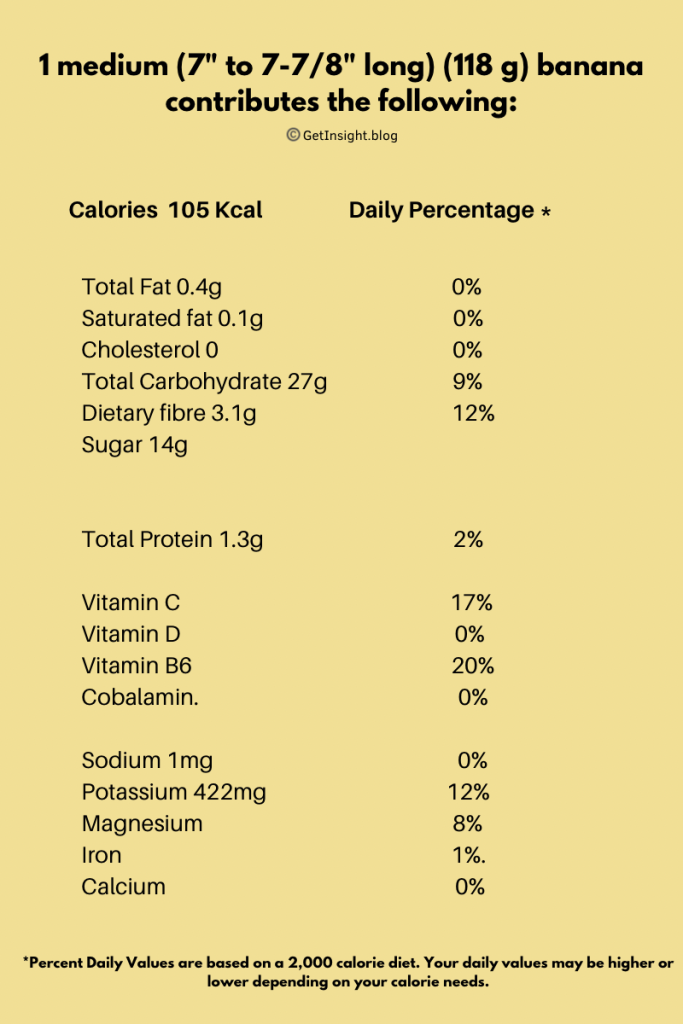Millions of people worldwide depend on bananas as a source of food or a way to earn. Bananas come from the plant class ‘Musa’, typically grown in warmer areas of the world, native to South-East Asia. Statistics reveal banana is one of the most important agricultural crops after cereals, sugar, and cacao. A study back in 2006, shows North America, Europe, and Japan are the leading importers of this superfood globally.
This article will discuss many facts about bananas and why they can be considered a superfruit.
Why Is Banana A Superfruit?
Different studies have shown over time that people who eat more fruits and veggies have an inverse relationship with some diseases. Bananas contain a good amount of carbohydrates, flavonoids, and carotenoids. Considering other fruits, it has less amount of antioxidants, but still, globally it is one of the highest consumed fruit. The nutritional facts will elaborate the fact why Banana is a Superfruit:
The Nutritional Facts About Bananas:
- A medium-sized banana provides approximately 105 Kcal, 93% of which comes from carbohydrates, 4% from protein, and 3% from fats. Because of its high-calorie content, it is a staple calorie source for over 500 million people in tropical countries.
- Bananas are major sources of dietary potassium. One medium-sized banana contains 0.4 gm of potassium. It is a very important mineral that helps in normal blood pressure regulation and kidney functions.
- Banana is also a good source of Vitamin B6 (pyridoxine). One of the major benefits of this vitamin is its protective power against oesophageal cancer.
- Unlike other fruits, banana does not provide a good amount of ascorbic acid (Vitamin- C) or Vitamin-A, but it has a generous amount of important minerals, like- Magnesium, copper, and manganese.
- The anti-oxidants present in bananas, generally secondary in nature, protect the body from oxidative damage. The flavonoids and carotenoids in bananas act effectively on the digestive system and other body organs.

Health Benefits Of Bananas:
Interestingly every part of the banana tree is used in different ways in many parts of the word. Pointing out some of the common health benefits of bananas at different stages:
Raw Bananas:
It is the green-colored banana- the unripe one. It requires cooking before consumption. there are many parts of the world that use this part as a vegetable, an essential part of making curries. It has anti-diarrhoeal properties and is traditionally used to treat dyspepsia.
Banana Flower & Stem:
Banana flowers and stems are also used widely in many regions of the world, contributing a good amount of dietary fiber to the daily diet. Moreover, it is cheap and quite easily available in local markets of many Asian countries, like- India.
Ripe Bananas:
This is the most widely used part of bananas. The color varies somewhere between yellow to brown. It is very popular among athletes as well as common people because of its wide availability in supermarkets/grocery stores at quite cheap prices and contributes a good amount of non-fat calories along with many important nutrients. Ripe banana helps in bowel movement as they help the gut microflora to grow by stimulating the growth of Lactobacilli and inhibiting the growth of pathogenic bacteria. The anti-inflammatory properties of ripe bananas make it very important to include them in daily diet.
Is Banana Good For People With Diabetes?
It has always been a part of the argument whether bananas can be included in the diet of those with type-II diabetes as it contains a very generous amount of carbohydrates. But it has to be understood that blood sugar level is directly increased when there are carbohydrates in a diet with a higher Glycemic Index (GI). As those sorts of foods release glucose more rapidly than that with a lower GI. Moderately ripe bananas have a low GI, which indicates it does not raise blood glucose level as rapidly as high-GI foods. So having one such banana may not adversely affect the health of an individual with type-II diabetes. Again, the amount of consumption should be moderate to the lower side as it is difficult to generalize how a body would react to a specific food.
Recommended Intake Guidelines for Bananas:
Daily consumption in moderate amounts is the key to getting all the benefits from the banana. One banana in breakfast in smoothie form or whole or combined with any other food is really a game-changer to kick start a day with lots of energy.
Industrial Use of Bananas:
- In the food industry, banana has become an integral part because of their chemical properties, it helps as a thickening agent, gelling agent, and stabilizer. Particularly, banana is important in the dairy industry as it helps to form odorless solvent, used in formulating desserts and other functional foods.
- Many Industries and enterprises have developed to utilize different parts of bananas and commercialize the products made from them, like- banana chips, pickles, etc.
In the end, it can be concluded that banana is definitely a superfruit as it is a powerpack of many good nutrients required for a healthy body and plays a pivotal role to keep our system healthy without making a hole in our pocket. Including one banana in your daily diet can be really a good habit in long run. Also, do not forget to try those tasty banana chips available in the market.
Signing off!
( If you have any questions/ suggestions please feel free to comment or contact us at getinsight.blog@gmail.com. We would love to hear from you. For more health-related articles you can click here. )
(Copyright 2023 Getinsight.blog)

